More results...
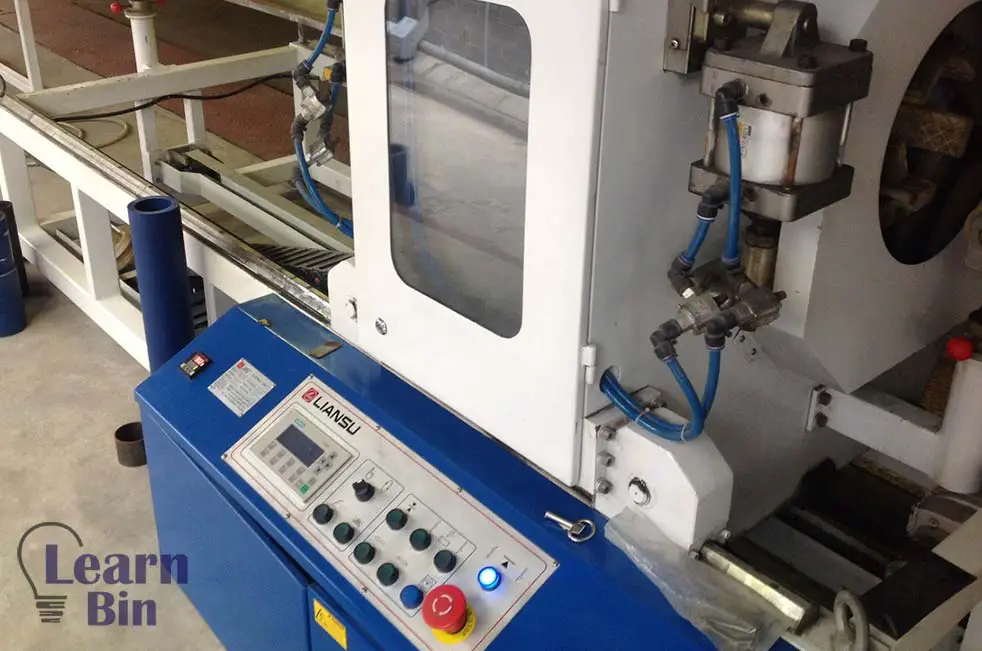

When manufacturing polymer products, raw materials are mixed with specific compounds which are also known as additives such as pigments, antioxidants, etc. This process is called compounding. There are some specific tools for compounding polymers. This article describes the most common mixing instruments in the polymer industry.
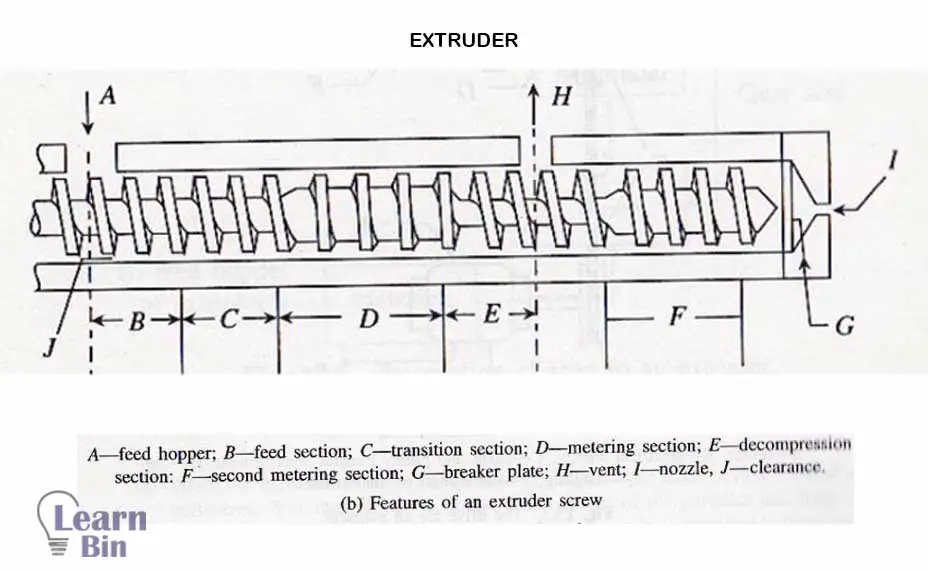
The extruder is the most common blending machine in the polymer industry. There are two different types of extruders in the industry. Those are mixing extruders and processing extruders.
Mixing extruders are used just only for blending and compounding purposes.
Processing extruders are used for both manufacturing final products and compounding purposes. In processing extruders, the compounding process occurs in the mixing chamber. The end of the chamber is connected to a mold or specific dies which give the shape of the final product, to obtain the end product.
After all, both mixing extruders and processing extruders have the same mechanism. But the design of the screws is different.
This is a machine with a parrel and screw. There are heating pads to supply heat externally for mixing. In the feeding section, no heat is applied. Because, if heat is applied to the feeding section, the material is going to be melted. if the material melted at the feeding section, it is difficult to insert new material. So, heat will apply to the transition section.
Along the shaft, there are spiraling threads which are called “flights”. The distance between two flights is called pitch. The pitch is changed along the shaft. The angle of flight is called “slant”. The slant is also changed along the shaft. The distance between the shaft and the wall of the chamber is called depth. It is changed along the shaft.
At the metering, section depth will decrease. So, a high shear force will apply to the material. Due to the high shear force, the temperature will increase. Then the material tries to reach its melting temperature or above. And a molten material will obtain. Molten material has a high viscosity and it is called “Flux”. Molten material will be pumped forward to the machine.
At the decompression, depth will increase again. In this section, the material is already melted and it is supplied shear force. Due to the sheer force, the viscosity of the material will reduce. This is called “Shear thinning”. If there are light materials such as moisture, are agglomerated and removed through the vent as water vapor.
At the second metering, section depth is reduced again. Then again, the temperature might be increased by about 5℃. Finally, a low viscous molten material will obtain. At the end of the chamber, there is a filter which is called a “Breaker plate” which filters unmolten particles and any other unwanted particles.
The mixing efficiency of the extrude depends on the (Length/Diameter) ratio of the screw.
| Materials that are going to be extruded | Length/Diameter ratio |
| Rubber | 10-20 |
| Thermoplastics | 20-30 |
Then, thermoplastic mixing extruders have a long and narrow screw. Rubber mixing extrudes have wide and short screws.
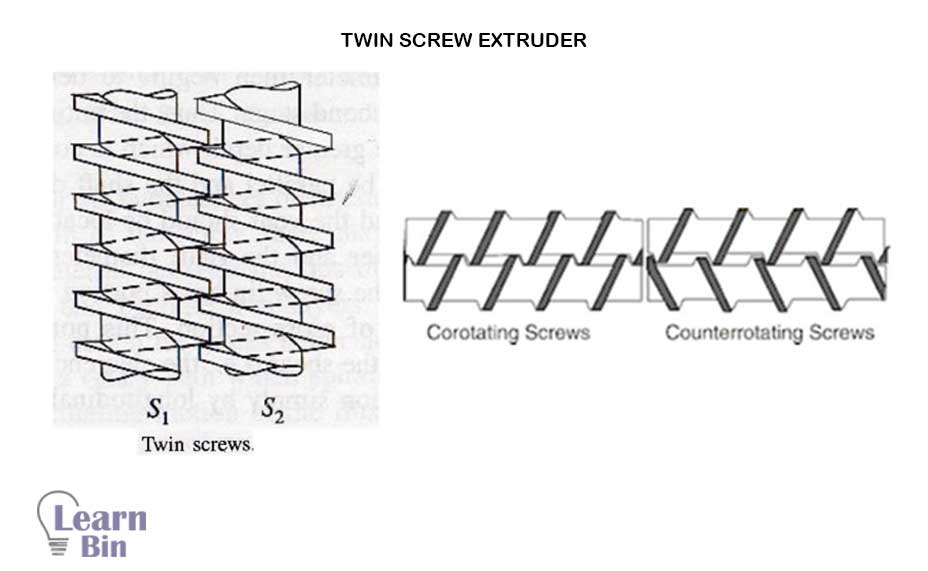
A twin-screw extruder is a type of extruder that has two screws in the mixing chamber. The rest of the machine is the same as the single-screw extruder. Two screws give additional shear force to the material. In the mixing chamber, two screws are placed side by side. In a counter-rotating system slant and pitch should be matched. Twin screws can be either co-rotating or counter-rotating.
In the counter-rotating machine, screws are going away from each other and materials will come to each other. The highest shear force is applied at the nip where the gap between two screws is. When blending the material, part of the material passes through the nip, and another part will pass to another screw. Different shear forces will apply at different places on the screw.
Counter-rotate twin-screw extruders have long mixing chambers; co-rotating twin-screw extruders have medium-length mixing chambers and single-screw extruders have long mixing chambers.
Single-screw extruders and co-rotating twin-screw extruders are self-cleaning machines. Counter-rotating extruders are difficult to clean.
An intensive dry mixture is mainly used to mix dry powder such as powdered resins and additives such as PVC with plasticizers, antioxidants, etc. This blender is similar to domestic blenders.
The motor speed of this mixture is around 80-160 rpm. In the middle of the instrument, there is an impeller. Impeller agitates resin creating a vortex. In the middle of the vortex, pressure is low. So, lighter materials will attract to the center of the vortex. If there is a high amount of moisture, they also will attract to the center of the vortex. This moisture can be removed through the valve as vapor. There are different types of impellers for different types of feed such as lumpy or sticky agglomerates.
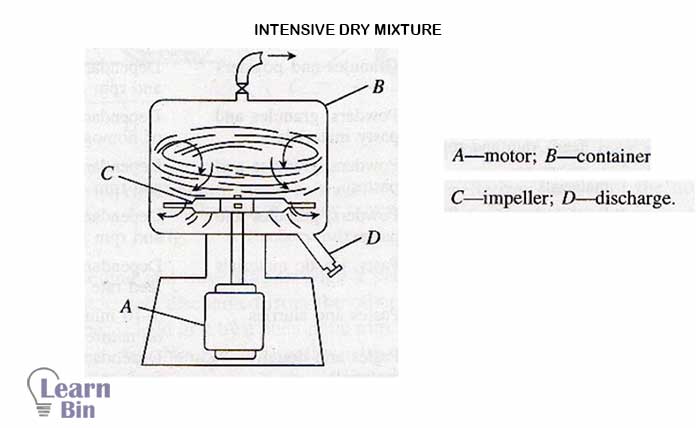
The internal intensive batch mixture also known as “Internal mixture” is generally used in the rubber industry. The materials to be blended are fed through a hopper. A ram pushes the material into the cavity. Inside the machine cavity, there are two counter-rotating rotors which are providing mixing action. These rotors are not completely cylindrical and they are interlocking. When applying the material to the machine, it will go through this interlocking system. So, the material is applied to high shear force. The area between these two rotors is very small. It almost touches the wall. Therefore, thinning of the material will happen. Folding, thinning, sandwiching, and wiping actions will occur inside the machine.
Due to the high shear force inside the machine, the molar mass and viscosity of the material will reduce. When applying highly viscous material to the machine, it generates heat while the mixing process. So, this machine should have a cooling system. So, an internal mixture not only externally, but also internally can be cooled.
While working the machine, the blended batch can be discharged through an opening in the bottom of the mixing chamber to the next processing step.
The internal mixture is a closed system. So, this machine is very safe and environmentally friendly. Health hazards are low since it is a closed system.
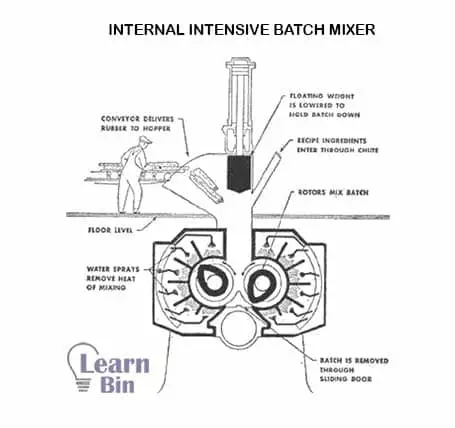
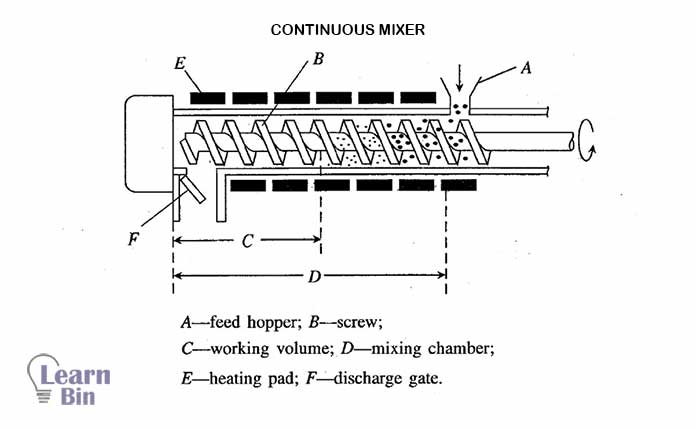
The continuous mixture is a barrel shape mixture. Inside the barrel, there is a screw which is providing mixing action. Due to the rotation of the screw, material travels from the feed hopper to the discharge gate through the mixing chamber. The rotational screw provides shear force to the material. This machine is a continuous machine. That means, the material can be continuously fed and continuously discharged.
The feeding materials have different sizes, different shapes, and different densities. Due to the sheer force, the material is completely mixed and it is in powder form when passing the working volume. After mixing, the material can be removed from the discharge gate.
The quality of the mixing is controlled by motor speed, feeding rate, and discharging rate. In other words, a slow feeding rate and slow discharging rate give high-quality mixing. In order to get a high-quality mixing with a fast feeding rate and fast discharging rate, motor speed should be increased.
If an increased motor speed at a slow feeding rate and slow discharging rate, it will cause to generate heat. Because the shear force is high in the mixing chamber. This generated heat is used for the mixing process. If this heat is not enough, heating pads can be used.
This machine is not a self-cleaning machine. So, after each processing machine should be cleaned.
Two roll mill is the simplest mixing device. Rubbery materials can be mixed in two roll mill. This is an open device with two independently rotating rollers. There is a core inside two rollers. Water can be passed through this core and cool or heat the material. Steam, boiling water, or cold water can be passed through the rollers in order to provide a cooling or heating process. There is a small gap between two rollers and it is called nip. Two rollers rotate toward each other at different speeds. Backroll rotates fast and the front roll rotates slowly.
The mixing process is start with a large nip size. Due to the speed difference between the two rolls, the shear force will generate between the rollers. This shear force is caused to break bonds of the material. So, molecular weight and viscosity will reduce. Normally, six mill passes will be done for each sample. After each pass of the mill, the nip size is reduced. After mixing, a sticky compound will obtain.
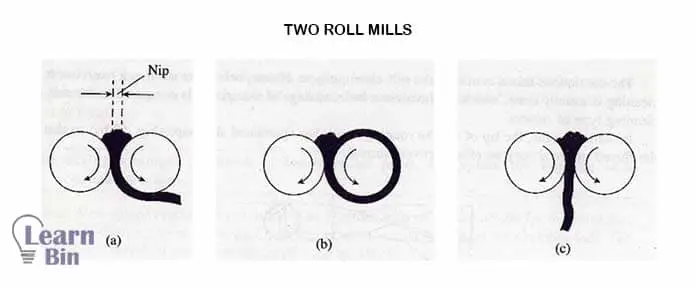
Two roll mill is, this is an open system. So, some additives which are very toxic can easily release into the environment. This is not environment friendly and it also causes health hazards. This is the main disadvantage of the two-roll mill.
The advantage of this machine is, this is a self-cleaning machine.
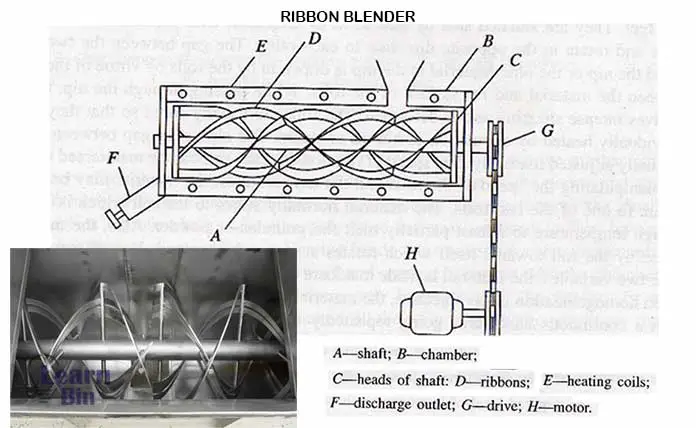
The ribbon blender is also a barrel shape mixing machine. In the mixing chamber, a metallic shaft is placed horizontally. Metallic belts are spiraling around the shaft. These ribbons are placed such that almost touch the wall. It gives a high shear force to the material. Material feeding is not continuous; it is a batch. Viscous, slurry, or pasty materials can be applied to this machine. The ribbon blender is not a self-cleaning machine.
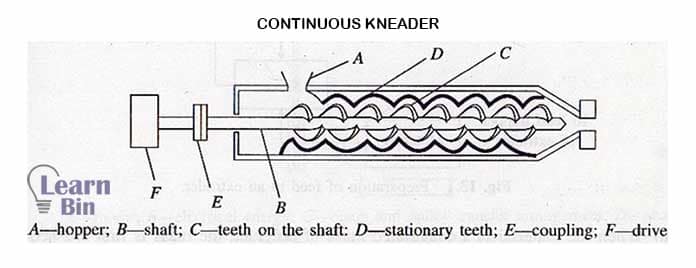
A continuous kneader is a barrel shape mixing machine with a mixing chamber and a shaft. There are a set of teeth along the shaft. On the wall of the mixing chamber, there are stationary teeth that give additional shear force. That will increase the efficiency of the mixing. When feeding the material, the shaft with teeth pushes the material forward.
The machine can be run in open or closed conditions. Light solids are mixed where the chamber is open. Materials such as slurry or pasty are processed under closed chamber conditions. This gives additional shear force to the material.
This machine can handle a large quantity of material per hour. This machine is not a self-cleaning machine; because sets of teeth will try to retain some materials in the machine.

The cover image was designed using a Photo by form PxHere